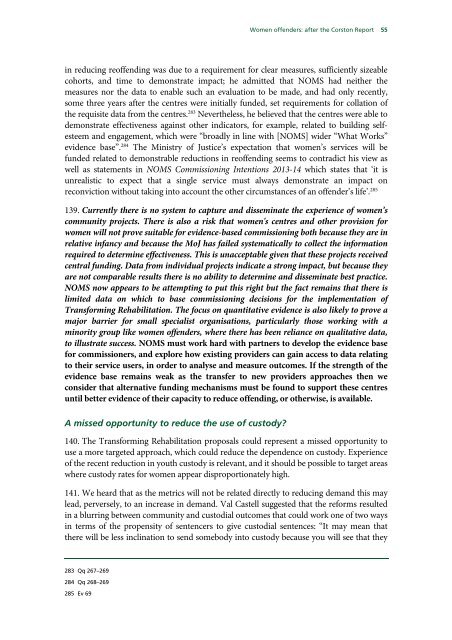Women offenders: after the Corston Report - United Kingdom ...
Women offenders: after the Corston Report - United Kingdom ...
Women offenders: after the Corston Report - United Kingdom ...
Create successful ePaper yourself
Turn your PDF publications into a flip-book with our unique Google optimized e-Paper software.
<strong>Women</strong> <strong>offenders</strong>: <strong>after</strong> <strong>the</strong> <strong>Corston</strong> <strong>Report</strong> 55in reducing reoffending was due to a requirement for clear measures, sufficiently sizeablecohorts, and time to demonstrate impact; he admitted that NOMS had nei<strong>the</strong>r <strong>the</strong>measures nor <strong>the</strong> data to enable such an evaluation to be made, and had only recently,some three years <strong>after</strong> <strong>the</strong> centres were initially funded, set requirements for collation of<strong>the</strong> requisite data from <strong>the</strong> centres. 283 Never<strong>the</strong>less, he believed that <strong>the</strong> centres were able todemonstrate effectiveness against o<strong>the</strong>r indicators, for example, related to building selfesteemand engagement, which were “broadly in line with [NOMS] wider “What Works”evidence base”. 284 The Ministry of Justice’s expectation that women’s services will befunded related to demonstrable reductions in reoffending seems to contradict his view aswell as statements in NOMS Commissioning Intentions 2013-14 which states that ‘it isunrealistic to expect that a single service must always demonstrate an impact onreconviction without taking into account <strong>the</strong> o<strong>the</strong>r circumstances of an offender’s life’. 285139. Currently <strong>the</strong>re is no system to capture and disseminate <strong>the</strong> experience of women’scommunity projects. There is also a risk that women's centres and o<strong>the</strong>r provision forwomen will not prove suitable for evidence-based commissioning both because <strong>the</strong>y are inrelative infancy and because <strong>the</strong> MoJ has failed systematically to collect <strong>the</strong> informationrequired to determine effectiveness. This is unacceptable given that <strong>the</strong>se projects receivedcentral funding. Data from individual projects indicate a strong impact, but because <strong>the</strong>yare not comparable results <strong>the</strong>re is no ability to determine and disseminate best practice.NOMS now appears to be attempting to put this right but <strong>the</strong> fact remains that <strong>the</strong>re islimited data on which to base commissioning decisions for <strong>the</strong> implementation ofTransforming Rehabilitation. The focus on quantitative evidence is also likely to prove amajor barrier for small specialist organisations, particularly those working with aminority group like women <strong>offenders</strong>, where <strong>the</strong>re has been reliance on qualitative data,to illustrate success. NOMS must work hard with partners to develop <strong>the</strong> evidence basefor commissioners, and explore how existing providers can gain access to data relatingto <strong>the</strong>ir service users, in order to analyse and measure outcomes. If <strong>the</strong> strength of <strong>the</strong>evidence base remains weak as <strong>the</strong> transfer to new providers approaches <strong>the</strong>n weconsider that alternative funding mechanisms must be found to support <strong>the</strong>se centresuntil better evidence of <strong>the</strong>ir capacity to reduce offending, or o<strong>the</strong>rwise, is available.A missed opportunity to reduce <strong>the</strong> use of custody?140. The Transforming Rehabilitation proposals could represent a missed opportunity touse a more targeted approach, which could reduce <strong>the</strong> dependence on custody. Experienceof <strong>the</strong> recent reduction in youth custody is relevant, and it should be possible to target areaswhere custody rates for women appear disproportionately high.141. We heard that as <strong>the</strong> metrics will not be related directly to reducing demand this maylead, perversely, to an increase in demand. Val Castell suggested that <strong>the</strong> reforms resultedin a blurring between community and custodial outcomes that could work one of two waysin terms of <strong>the</strong> propensity of sentencers to give custodial sentences: “It may mean that<strong>the</strong>re will be less inclination to send somebody into custody because you will see that <strong>the</strong>y283 Qq 267–269284 Qq 268–269285 Ev 69
















